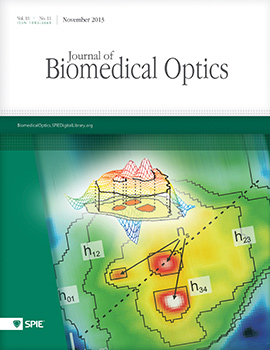Shinsuke Morisaki, Chikashi Ota, Ken-ichi Matsuda, Natsuko Kaku, Hiroyoshi Fujiwara, Ryo Oda, Hidenobu Ishibashi, Toshikazu Kubo, Mitsuhiro Kawata
Journal of Biomedical Optics, Vol. 18, Issue 11, 116011, (November 2013) https://doi.org/10.1117/1.JBO.18.11.116011

TOPICS: Raman spectroscopy, Nerve, Axons, Injuries, Tissues, Proteins, Nerve regeneration, Visualization, In vitro testing, In vivo imaging
Raman spectroscopy can be used for analysis of objects by detecting the vibrational spectrum using label-free methods. This imaging method was applied to analysis of peripheral nerve regeneration by examining the sciatic nerve in vitro and in vivo. Raman spectra of intact nerve tissue had three particularly important peaks in the range 2800−3000 cm−1 . Spectra of injured sciatic nerves showed significant changes in the ratio of these peaks. Analysis of cellular spectra suggested that the spectrum for sciatic nerve tissue reflects the axon and myelin components of this tissue. Immunohistochemical analysis showed that the number of axons and the myelinated area were reduced at 7 days after injury and then increased by 28 days. The relative change in the axon to myelin ratio showed a similar initial increase, followed by a decrease at 28 days after injury. These changes correlated with the band intensity ratio and the changes in distribution of axon and myelin in Raman spectral analysis. Thus, our results suggest that label-free biochemical imaging with Raman spectroscopy can be used to detect turnover of axon and myelin in peripheral nerve regeneration.


 Receive Email Alerts
Receive Email Alerts